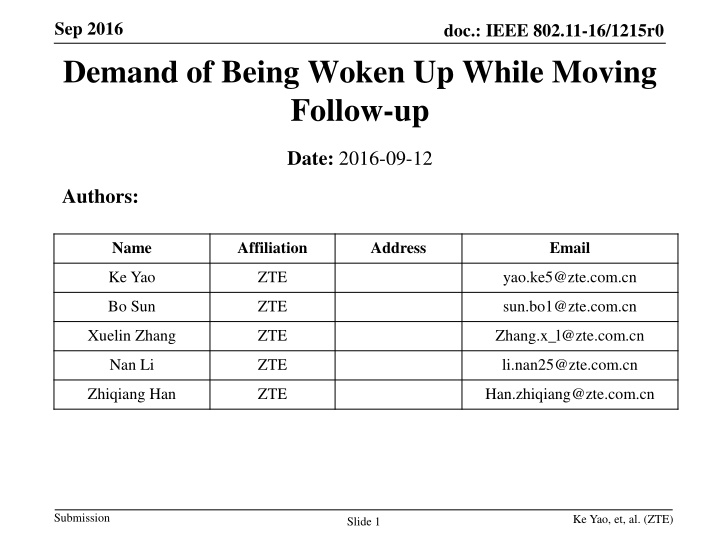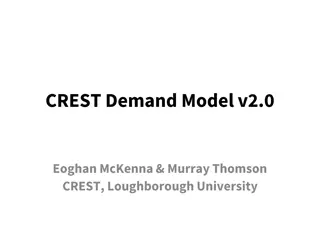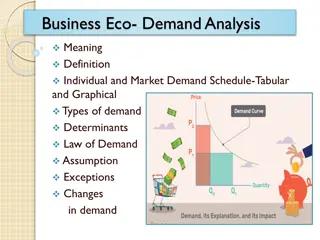
WUR Moving Support for Enhanced IoT Connectivity
Explore the IEEE 802.11 standard's approach to waking up IoT devices as they move between access points, enhancing power-saving efficiency in IoT implementations. Learn about the requirements, analytics, and support mechanisms for enabling seamless transitions.
Download Presentation

Please find below an Image/Link to download the presentation.
The content on the website is provided AS IS for your information and personal use only. It may not be sold, licensed, or shared on other websites without obtaining consent from the author. If you encounter any issues during the download, it is possible that the publisher has removed the file from their server.
You are allowed to download the files provided on this website for personal or commercial use, subject to the condition that they are used lawfully. All files are the property of their respective owners.
The content on the website is provided AS IS for your information and personal use only. It may not be sold, licensed, or shared on other websites without obtaining consent from the author.
E N D
Presentation Transcript
Sep 2016 Demand of Being Woken Up While Moving Follow-up doc.: IEEE 802.11-16/1215r0 Date: 2016-09-12 Authors: Name Affiliation Address Email Ke Yao ZTE yao.ke5@zte.com.cn Bo Sun ZTE sun.bo1@zte.com.cn Xuelin Zhang ZTE Zhang.x_l@zte.com.cn Nan Li ZTE li.nan25@zte.com.cn Zhiqiang Han ZTE Han.zhiqiang@zte.com.cn Submission Ke Yao, et, al. (ZTE) Slide 1
Sep 2016 doc.: IEEE 802.11-16/1215r0 Background WUR is aiming to promote the 802.11 s performance of power-saving especially for IoT implementations. IoT has very broad market instances with rich implementations. Some of them may request the IoT terminals to be woken up from sleeping mode after moving to another AP[1]. We explained the requirement for such moving use case and studied the feasibility in this contribution. Submission Ke Yao, et, al. (ZTE) Slide 2
Sep 2016 doc.: IEEE 802.11-16/1215r0 Recap the WUR Moving Requirement WUR STAs which move to another AP within a certain domain such as WUR group can be woken up on demand Note: WUR group refers to a group of BSSs within which a served IoT terminal uses an unique wake-up ID Some applications request the IoT terminals to be moved when they are in deep sleep mode WUR module is supposed to keep open and stay in a fixed channel(s) waiting for the wake-up signals The WUR Moving feature means the WUR STAs can be woken up by a new AP of the same WUR group. Submission Ke Yao, et, al. (ZTE) Slide 3
Sep 2016 doc.: IEEE 802.11-16/1215r0 Analytics of Support to WUR Moving To support WUR moving Note: WUR STA refers to a STA with WUR module, while WUR AP means an AP support to wake up WUR STA. The WUR AP should be capable of paging a WUR STA with a global ID which is not connected to it. The WUR AP may send wake up message to a non-associated WUR STA The WUR AP may change its original WU signal channel when there are more than one wake up signal channels The WUR AP needs to support an extra discovery delay when it cannot get response from a WUR STA that s ever connected to it within a regular delay. The WUR AP should not disassociate the WUR STA before the extra discovery delay. The WUR STA should be able to be woken up with a global ID in a range larger than BSS, e.g. ESS or even larger. The WUR STA needs to respond to a WUR AP which is not its original BSS AP. This will be discussed in following slides. Submission Ke Yao, et, al. (ZTE) Slide 4
Sep 2016 doc.: IEEE 802.11-16/1215r0 Illustration of WUR Moving Support Submission Ke Yao, et, al. (ZTE) Slide 5
Sep 2016 doc.: IEEE 802.11-16/1215r0 WUR STA Response - Approaches Approach 1: complete access procedure in 802.11i WUR STA performs the complete association procedure which is widely used nowadays to access to the new AP Approach 2: FILS (Fast Initiate Link Setup) in 802.11ai Make use of the FILS scheme to speed up access process Submission Ke Yao, et, al. (ZTE) Slide 6
Sep 2016 doc.: IEEE 802.11-16/1215r0 Approach 1: complete access procedure in 802.11i WUR STA performs the complete association procedure to access to the new AP Scanning Authentication, association, key negotiation IP address assignment Communication with its application server Pros and Cons Keep the current widely used access procedure, no need to modify for WUR moving Large delay, high overhead, low power efficiency Scenarios Can be used for all kinds of WLAN devices Not practical for some very low traffic requirement, especially the frequently changing AP application Submission Ke Yao, et, al. (ZTE) Slide 7
Sep 2016 doc.: IEEE 802.11-16/1215r0 Approach 1 Cont. The normal procedure for a STA to access an AP [3] Tens of message exchanges among STA, AP and other entities Several hundreds of ms !! Submission Ke Yao, et, al. (ZTE) Slide 8
Sep 2016 doc.: IEEE 802.11-16/1215r0 Approach 2: FILS in 802.11ai WUR STA could also perform Fast Initiate Link Setup procedure to access the new AP Scanning is simplified in 11ai Authentication, association, key negotiation and IP address assignment can be combined to 4 steps. Pros and Cons Delay and power consumption become more acceptable May rely on the maturity of 802.11ai Scenarios Can be used for most applications Submission Ke Yao, et, al. (ZTE) Slide 9
Sep 2016 doc.: IEEE 802.11-16/1215r0 Approach 2 Cont. FILS shared key authentication [2] The access time is expected to be shortened to less than 100ms Submission Ke Yao, et, al. (ZTE) Slide 10
Sep 2016 doc.: IEEE 802.11-16/1215r0 Further considerations Since Approach 2 is not very time-consuming, it should be suitable for most IoT moving applications. Considering higher power efficiency demand, some methods could be deployed to further reduce the delay, at the price of modification on the current access procedure. Design simpler access procedure especially for WUR moving The old AP may share the WUR STA s information with the new AP to reduce the WUR STA s transmission burden Submission Ke Yao, et, al. (ZTE) Slide 11
Sep 2016 doc.: IEEE 802.11-16/1215r0 Summary We discussed the WUR moving conception and function support. Possible approaches were introduced Approch 2 seems to be acceptable. Whether or not need to modify the current access procedure for better power efficiency depends on the tradeoff between complexity and power save requirement in the real implementations. Submission Ke Yao, et, al. (ZTE) Slide 12
Sep 2016 doc.: IEEE 802.11-16/1215r0 References [1] 11-16-0931-00-0wur-demand-on-roaming-for-wur [2] Draft P802.11ai_D10.0 [3] 11-11-0977-06-00ai-tgai-upper-layer-setup-proposal Submission Ke Yao, et, al. (ZTE) Slide 13
Sep 2016 doc.: IEEE 802.11-16/1215r0 Straw Poll Do you agree that WUR moving should be supported by WUR standard? Y N A Submission Ke Yao, et, al. (ZTE) Slide 14






















